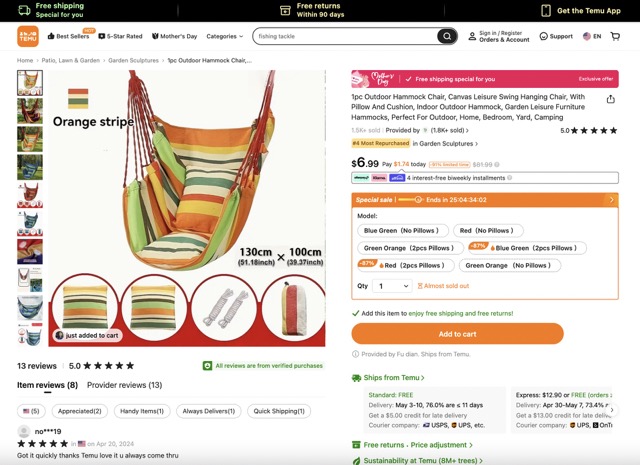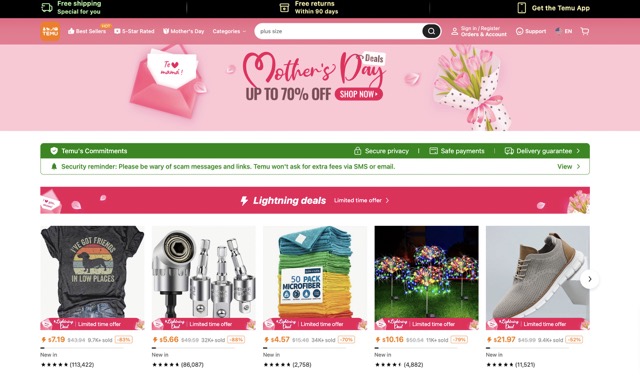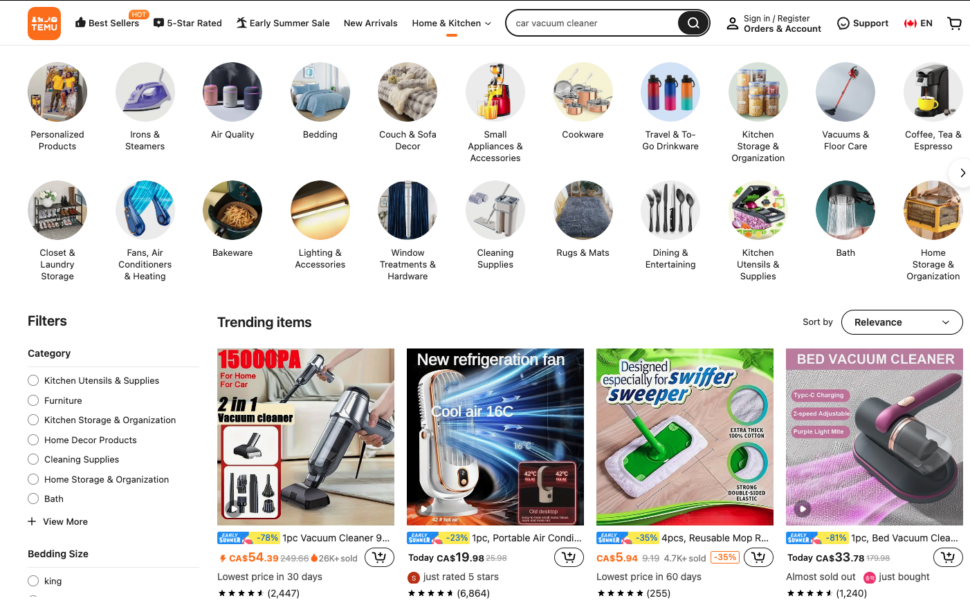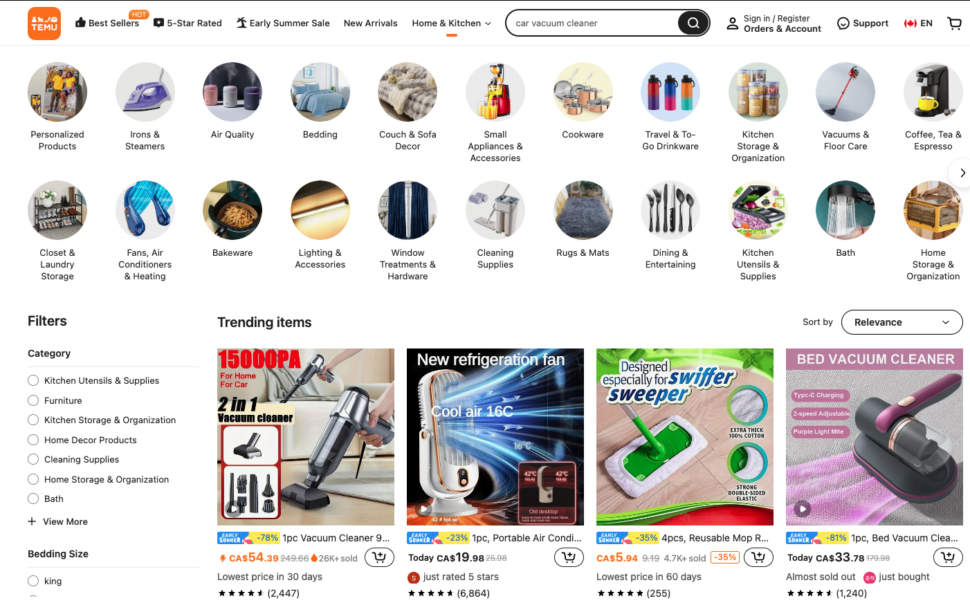Can you sell on Temu, and how does it work? This guide explains that Temu only allows manufacturers, not resellers or dropshippers, to sell on its platform. It outlines how to apply for a seller account, list products, and compete in a low-cost, high-volume marketplace. With steps for setting up your store, insights on fees, and optimization tips using tools like PickFu, this article answers key questions like “How do I start selling on Temu?” and “What are the requirements and costs?”
Temu is an e-commerce platform based in China, but rapidly growing in popularity in the U.S.
The consumer-to-manufacturer platform is designed to link buyers directly with the products at their source. The parent company, Pinduoduo, aka PDD Holdings, aimed originally to improve the link between Chinese manufacturers and their end users. It launched Temu for consumers in the U.S. in 2022.
Consumers are attracted by the extremely low prices of many items on the online marketplace. That low price tag is due largely to Temu’s unique model. It connects consumers directly to the manufacturer, which cuts costs. Ultimately, consumers pay wholesale rates for the goods they buy on Temu.
In early 2022, Temu was the most downloaded app on the App Store, eventually reaching 80 million active users in September 2023.
So how can e-commerce sellers capitalize on this growth and audience?
As of now, the only way to sell on Temu is to be a manufacturer. You can’t dropship on Temu. The site was developed to connect consumers directly to companies, mostly in China, that create their own goods. If you are a manufacturer, even if you’re not based in China, you can sell on Temu directly to the public using their e-commerce site.
Temu vs. Amazon
The key difference in the approach from Temu vs. Amazon is that Temu doesn’t allow third-party sellers, or “middlemen.”
One irony of the Temu model is that it makes it easier for Amazon resellers to find the items they want from manufacturers on Temu, import them, and then sell them on Amazon for a profit. Many Amazon FBA sellers do just that, as you’ll see in this YouTube video and in our example image below.
If you want to sell on Temu, you have to be a manufacturer, not a reseller or dropshipper. In contrast, Amazon allows anyone to set up an account and sell or resell almost anything.
Temu fees and charges vs. Amazon
Amazon charges sellers a percentage of the items they sell, based on the category of goods they are selling. Individual sellers pay $0.99 cents per item on top of that. Business sellers pay a $39 per month fee to sell on the platform, and then only pay a percentage of the items sold after that.
Temu charges a referral fee as well, but it’s free to set up an account and start selling. The actual costs depend on the category of goods, but there is no extra cost for selling beyond the tiered commissions.
Shipping from Temu vs. Amazon
Amazon FBA sellers also pay shipping costs and handling fees per item. Whether or not you find Amazon FBA worth it will depend on your access to shipping and warehousing facilities.
While setting up a seller account on Temu is free, the marketplace also charges a fee per item sold, and the fee changes depending on what product category you’re in, just like Amazon. Because most sellers on Temu sell on consignment and use Temu’s services, it’s hard to find the exact costs for fulfilling through Temu’s platform.
The startup costs for both platforms are small, but product development costs and manufacturing costs are a bigger barrier to Temu sellers.
Setting up a seller account on Temu

If you do meet the criteria and are selling directly as a manufacturer, you can set up a Temu seller account.
Here’s a step by step guide to selling on the Temu online store:
Step 1: Reach out to Temu
If you want to become a seller on Temu you’ll need to register your interest by emailing them at merchandise@temu.com. You will find this address on the “Partner with Temu” page, which you can access in the footer of the Temu website.
Step 2: Apply for a seller account
Temu will send you a seller code and a link to create a seller account. You can also download the Temu app for sellers. This is where you’ll apply by listing your business information like:
- Name
- Address
- Website
- Phone number
- Billing information
- Bank details
You’ll also need to choose a name for your Temu shop that is unique and reflects the type of products you make and sell.
Temu requires all sellers to abide by its Code of Conduct and intellectual property policies.
Step 3: List your items
Once your seller profile on Temu is approved you can start listing products. Your product listing should include:
- High-quality photos
- A detailed description of the item
- Detailed specifications including dimensions, weight, etc
- Relevant keywords that help consumers find your product
Step 4: Manage stock levels
Temu operates mostly as a consignment store, where it handles most of the logistics including shipping and warehousing for items listed on the site.
It only recently allowed businesses to ship and service orders from their own warehouses. If you ship from your own warehouse or logistics provider, you will need to pay careful attention to inventory levels and product quality.
Tips for selling successfully on Temu

Selling on Temu is similar to selling on Amazon, in that there are rules and policies in place to ensure a good customer experience. The key difference is in the types of products offered. Here’s how to make sure your Temu store is a success.
Careful market research
Make sure you’ve thoroughly researched the marketplace and your competitors before you start selling on Temu. You should have a well-considered pricing strategy based on your planned profit margins, but also on the cost of goods found elsewhere in the platform.
You should also consider the marketing strategies of your rivals and plan your own approach to explore opportunities they might be missing.
You can directly compare your own products with your competitors’ using PickFu Head-to-Head or Ranked polls to get a sense of where you need to improve.
Respond quickly to customers

Fast shipping is important, but so is quickly responding to customer questions and complaints. Temu has a ratings and review system, just like Amazon. The best sellers on Temu have good ratings for both product quality and customer service. A strong customer feedback strategy and return policy will help you succeed on the platform.
Optimize your listing
Marketplace optimization has several components. They include:
- Keyword optimization
- Image selection
- Headline selection
Keyword optimization requires you to understand what your customers are looking for, and how they’ll search for your product. Choose keywords that align with your product and its intended use.
Image selection and headline selection are important to capture attention. There are more than 100,000 sellers on Temu, so it’s important to stand out.
PickFu can help you validate, test, and retest your product listings using our suite of user-friendly market research tools. Our built-in audience panel and survey tools can help you verify your listings on any marketplace.
When health-food maker Yes Bar used PickFu to optimize a product listing image, they saw an 11.8% boost in traffic. You can use PickFu to test your product ideas, designs, images, and more on any e-commerce marketplace, not just Temu. And you can target your ideal customer using 90+ demographic traits, including location, income, gender, age range, and much more.
Testing the market first using a consumer insights platform is better than live split testing on Temu (aka, posting the same product under different images and product titles). Using PickFu to optimize your listing before you go to market ensures you don’t alienate any potential customers in the real world and means your product has the best possible chance of success from minute one.
Stay on top of Temu policies
There are a range of prohibited products on Temu. The list of these changes often, usually based on intellectual property claims, changing regulations, or shipping challenges. You can find the list in your Temu seller dashboard.
Sell on Temu the right way

It can be tricky to get set up on Temu, and that’s by design. The platform wants to keep prices low and help businesses who actually manufacture products connect directly with their target market.
Once you are set up however, competition is fierce, and just like any other online marketplace it’s important to use all the tools available to stand out.
That means using tools like PickFu to drive the most traffic to your listings, and in turn, generate the most sales. You can also use PickFu to help validate and prototype your products throughout the development process, bringing your goods to the Temu marketplace with a higher chance of success.
Selling on Temu FAQs
How can I increase marketplace traffic?
Methods that increase traffic to Amazon listings are transferable to all marketplaces, including Temu. They include: performing market research, testing product images, testing headlines, and optimizing your listing using keywords.
How can I make money from Temu if I don’t manufacture goods?
Temu supports affiliate marketing. If you sign up for the Temu affiliate program you can use a referral code to get commissions on products. This works well if you use Temu products in how-to-videos or if your network is large.
If you have a large public presence and know how to sell on TikTok you can apply to Temu’s influencer program. The site will pay referral commissions, as well as potential bonuses and even offer free products to people in the program.
Can I use research on Temu and Amazon?
If you’ve already used PickFu to run Amazon AB testing for your products, you can use those same results to create your listing on Temu. Once you know an image or headline is appealing to your target audience, you can use that data on any marketplace you go on.
What is dropshipping?
Dropshipping is when an online store forwards purchase orders to a supplier who packs and distributes the item for the customer. Ali Express is an example of a dropshipping website, and Amazon allows dropshipping in some circumstances.
Does Temu allow dropshipping?
Temu forbids dropshipping from the website as it’s contrary to the company’s goal of connecting consumers directly to the manufacturer. Dropshippers can use Amazon to sell items, but not Temu.
Why is e-commerce popular?
If you’re considering selling online and wondering “is e-commerce worth it?” consider this: Most people use the internet multiple times a day. Our smartphone is almost permanently connected to our hands. Market research suggests that more than 330 million people in the USA alone will use e-commerce to make purchases by the year 2029. Currently, that number is just over 260 million.



